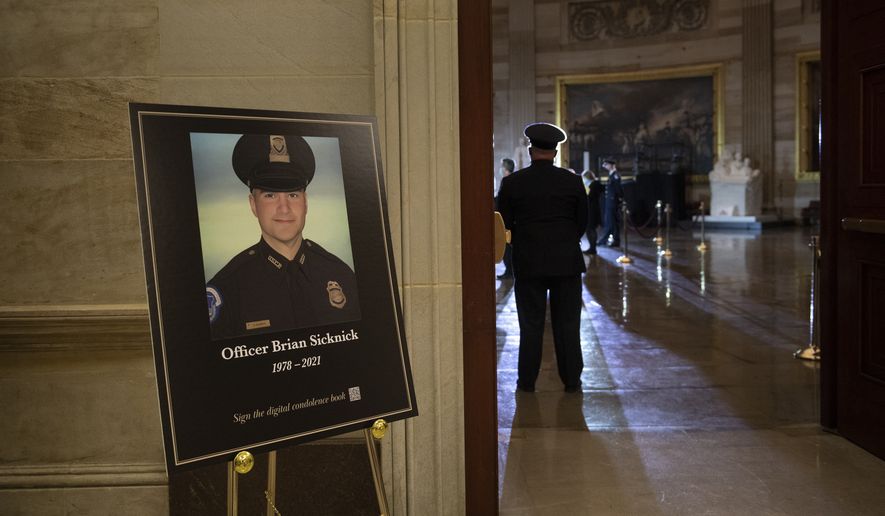Nearly two months after Capitol Police Officer Brian Sicknick died following clashes with rioters at the U.S. Capitol, the cause of his death remains a mystery, though earlier reports he was beaten with a fire extinguisher have been discredited.
Federal and state officials have been silent about the cause of death and attempts to clear up conflicting reports are met with resistance.
At a Senate Judiciary Committee hearing this week, Sen. Charles E. Grassley, Iowa Republican, voiced the public’s frustration, telling FBI Director Christopher A. Wray: “We all want to know what happened.”
Mr. Wray said he had no information to share. He refused to even divulge if the FBI concluded how Sicknick died.
“There is an ongoing investigation into his death,” Mr. Wray said. “We’re not at a point where we can disclose or confirm the cause of death.”
The FBI’s latest theory is that the 42-year-old Sicknick suffered a stroke after inhaling an aerosol-based “bear spray” during the riot, according to recent reports that authorities refuse to confirm.
It is not clear if bear repellent is fatal to humans. Representatives of two bear spray companies, concerned about bad publicity if their products were connected to the riot, declined to answer questions from The Washington Times.
The New York Times also reported this week that the FBI was zeroing on an assailant.
Investigators are said to be reviewing a video of the rioter attacking Sicknick with bear spray during the attack, the Times reported.
But the potential suspect has not been named — authorities won’t even confirm if a suspect has been pinpointed.
The Justice Department and D.C. police opened a joint investigation after Sicknick died in a hospital on Jan. 7, the day after pro-Trump demonstrators stormed Congress to stop the counting of Electoral College votes in favor of President Biden.
Then-acting Attorney General Jeffrey Rosen said they would “spare no resources investigating and holding accountable those responsible.”
The Sicknick investigation has not publicly yielded any results.
Federal prosecutors have criminally charged roughly 250 people with involvement in the riot, but no one has been indicted for the death of Sicknick, a 13-year veteran of the force.
A spokeswoman for the D.C. Office of the Chief Medical Examiner, which conducted an autopsy on Sicknick, declined to say when it would release its findings.
Under the National Association of Medical Examiners’ guidelines, the cause and manner of death must be released within 90 days. However, there are exceptions for complicated cases that take longer.
In a statement last week, the Capitol Police said the Medical Examiner’s report is “not yet complete” and they were awaiting toxicology results.
The department announced the day after the riot that Sicknick responded to the attack and “was injured while physically engaging with protesters.
“He returned to his division office and collapsed,” the statement said. “He was taken to a local hospital where he succumbed to injuries.”
Even the reports of his death have been marred with confusion.
Hours before Sicknick’s death, Gus Papathanasiou, chairman of the Capitol Police Force Union, told a D.C. television station that the officer was already dead.
The Capitol Police immediately rushed out a statement insisting reports of Sicknick’s death were “not accurate.” Mr. Papathanasiou retracted his statement.
In a CNN interview that evening, Mr. Papathanasiou said there had been “misinformation” about Sicknick’s condition. CNN had also prematurely reported his death, citing three sources.
Mr. Papathanasiou later said Sicknick suffered a stroke, which was the same explanation provided by Sicknick’s family.
CNN isn’t alone in misreporting on the case.
The New York Times in January reported that protesters bludgeoned Sicknick to death with a fire extinguisher. A story later that day said being hit with a fire extinguisher caused a “bloody gash” on Sicknick’s head.
A few weeks later, the Times backtracked from the fire extinguisher story and even issued a clarification to previous stories about Sicknick’s death. The clarification states that “new information” raised questions about the cause of death initially offered by sources close to the investigation.
Sicknick’s brother told ProPublica that he got a text from Sicknick after the riot saying he got pepper-sprayed twice but was in good shape.
The next day, the family was told that Sicknick had suffered a blood clot and a stroke, according to the brother.
Sicknick’s mother said the family is also in the dark about what exactly happened, though they believed that being bludgeoned was not the cause of death.
“He wasn’t hit on the head, no. We think he had a stroke, but we don’t know anything for sure. We’d love to know what happened,” she said in an interview.
• Jeff Mordock can be reached at jmordock@washingtontimes.com.




Please read our comment policy before commenting.